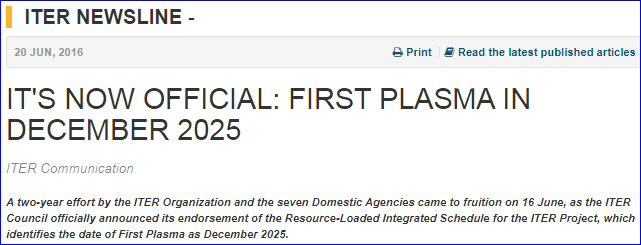#94 ITER “First Plasma” Date Slips Again; Fusion Organization Moves Goalposts
Return to ITER Power Facts Main Page
By Steven B. Krivit
Nov. 27, 2021
The ITER project has officially fallen behind schedule again. However, instead of explaining the delay, the organization now says its previous progress benchmark was never a “real target.”
In a press release issued at the end of the semiannual meeting of the ITER Council on Nov. 17-18, the ITER organization said nothing about the long-touted milestone of “first plasma in 2025.”
Instead, the organization said the new goal is “fusion power operation,” which, it claims, it can achieve in 2035. The “fusion power” milestone would mark the completion of experiments with test fuels and the beginning of experiments with a deuterium-tritium fuel mixture.
First plasma will be the milestone marking the end of construction of all the required reactor components and the beginning of experiments with test fuels.
In an earlier press conference, on Sept. 17, 2021, Bernard Bigot, the director-general, implied that “first plasma” was an artificial target date. After telling journalists that “first plasma in 2025 is no longer technically achievable,” he said, “We will be able to keep to the real target” — deuterium-tritium experiments by 2035.


New Energy Times first reported the expected delay of the first plasma milestone six months ago.
On Sept. 26, 2021, we reported that component issues are the real reason for the reactor delay.
On Oct. 26, 2021, we reported that the realistic and achievable date for first plasma is now 2031. We also reported that, based on our analysis and information, the realistic and achievable date for “fusion power operation” is not 2035, but 2039.
According to our timeline projections, ITER scientists will run experiments with full input power no earlier than 2041 — just 20 years from now.
Finally, if ITER achieves its scientific goal, the fusion plasma will produce a thermal output 10 times higher than the heating power injected into the plasma. If this happens, the correlated net output of the reactor will be about zero, thus proving that large-scale fusion reactors like ITER are not a viable path to commercial fusion energy.

